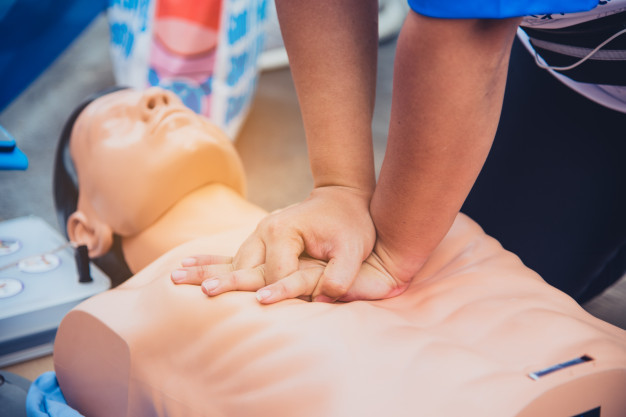Basic Life Support certification is essential for healthcare providers and many others who might encounter life-threatening emergencies. With over 350.000 cardiac arrests occurring annually, understanding BLS is crucial for increasing survival chances. This guide explores what BLS is, how to obtain certification, why it is essential, who needs it, and what the certification course includes.
What is Basic Life Support (BLS)?
Basic Life Support (BLS) is a level of medical care used to treat victims of life-threatening illnesses or injuries until they can receive full medical care at a hospital. BLS techniques include:
- Cardiopulmonary Resuscitation (CPR): To keep the heart pumping and provide oxygen to the lungs, there is a need to perform chest compressions and rescue breaths.
- Automated External Defibrillator (AED): A device that can deliver an electric shock to the heart to restore a normal rhythm.
- Choking Relief: Techniques to clear the airway of an obstruction.
How to Get BLS Certification
Obtaining a basic life support certification involves several steps to ensure thorough training and competence in performing essential life-saving skills. Here’s the process:
- Find a Course
Look for accredited organizations to take up your BLS course. Many hospitals, community centers, schools, and online platforms provide these courses.
- Register for a Course
You can choose an in-person, online or hybrid course that fits your schedule.
- Attend the Training Sessions
Participate in all training sessions, which typically include video demonstrations, lectures, and hands-on practice. You will learn proper techniques for CPR, AED use, and choking relief.
- Pass the Exam
At the end of the course, you will take a written exam to test your knowledge and a practical exam where you demonstrate your skills. The practical exam often involves performing CPR on a manikin and using an AED.
- Receive Your Certification
Upon successful completion of the exams, you will receive your BLS certification card. This card is usually valid for two years, after which you will need to take a renewal course to maintain your certification.
Why is BLS Certification Essential?
BLS certification equips individuals with the knowledge and skills to make a difference in case of emergencies. Here are the key reasons why BLS certification is essential:
- Life-Saving Skills
By undergoing BLS training, you have the skills to respond in emergency cases like cardiac arrest. Immediate and appropriate action can significantly increase survival and recovery chances.
- Job Requirement
Basic life support certification is often required for employment in healthcare and public safety sectors. Nurses, doctors, paramedics, firefighters, police officers, and lifeguards are examples of professionals who must be BLS certified.
- Preparedness
Being BLS certified means you are prepared to handle emergencies not just at work but also in everyday life. Whether at home, in public places, or during recreational activities, you can make a difference in critical situations.
- Improving Patient Outcomes
Early intervention with BLS can significantly improve outcomes for patients experiencing cardiac arrest or other life-threatening conditions. Until advanced care is available, the skills you learn can help maintain vital functions in the body.
Who Needs BLS Certification?
Basic life support certification isn’t just for healthcare-workers- many people across various fields can benefit from this. Knowing how to respond in case of an emergency can make a significant difference.Here’s a look at who should consider getting BLS certified:
- Healthcare Professionals: Doctors, nurses, paramedics, and other medical staff need BLS certification to provide immediate care in medical emergencies.
- Public Safety Personnel: Firefighters, police officers, and lifeguards often encounter emergency situations and need to act quickly and effectively.
- Caregivers: Those caring for children, the elderly, or disabled individuals should be BLS certified to handle potential emergencies.
- Teachers and Coaches: School staff and sports coaches are responsible for the safety of children and young adults, making BLS certification an important asset.
- General Public: Anyone who wants to be prepared to help in an emergency, such as family members, community volunteers, or workplace safety officers, can benefit from BLS certification.
What’s Included in the BLS Certification Course?
A Basic life support certification course covers various critical areas to ensure that participants are well-prepared to handle emergencies. Here’s a detailed look at what’s included in the course:
CPR Techniques
Learn to perform CPR on adults, children, and infants, including proper methods of chest compressions and rescue breaths.
AED Use
Training on how to use an Automated External Defibrillator (AED) is a key part of the course. You’ll learn to recognize when an AED is needed and how to operate it safely and effectively.
Choking Relief
The course teaches how to relieve airway obstructions in adults, children, and infants including the Heimlich maneuver and back blows.
Team Dynamics
How to work effectively as part of a resuscitation team, including clear communication and role allocation.
Critical Thinking and Assessment
How to quickly assess emergency situations and make informed decisions about the best course of action.
Summing Up
Basic Life Support certification is an invaluable skill set that prepares individuals to respond effectively to life-threatening emergencies. Whether you are a healthcare professional, a public safety worker, a caregiver, a teacher, or simply a concerned citizen, being BLS certified can make a significant difference in critical situations. By getting certified you can be more prepared in case of emergencies.

